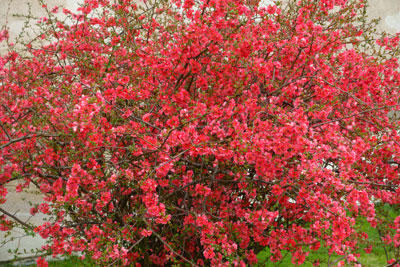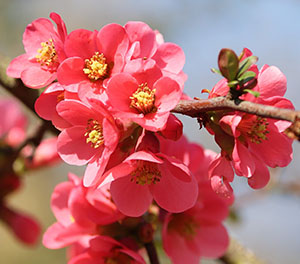Resource Library
Plant of the Week: Quince, Flowering (Japonica)
The University of Arkansas System Division of Agriculture does not promote, support or recommend plants featured in "Plant of the Week." Please consult your local Extension office for plants suitable for your region.
Plant of the Week
Flowering Quince, Japonica
Latin: Chaenomeles speciosa
Like most rural areas, Arkansas country folk have been moving closer to larger cities
so they can support their  families. This exodus from the land is not a new phenomenon, having started over a
century ago.
families. This exodus from the land is not a new phenomenon, having started over a
century ago.
The nation’s farm population peaked in the 1890s and has been declining ever since. In the spring, it's easy to spot these old homesteads because a few of the plants that adorned their dooryard gardens still remain. One of the most lasting is a shrub they called Japonica.
What are the characteristics of Flowering Quince?
More sophisticated gardeners know this plant as Flowering Quince (Chaenomeles speciosa), but old timers still call it Japonica. It's a round-topped, deciduous shrub growing 6 feet tall and 10 feet across. These old plants become a tangle of branches, but they persist for years without benefit of pruning. Flowering quince produces stout thorns and, at one time, it was common to see hedges made from it.
Foliage
Quince foliage emerges maroon-green in the spring just as the flowers are fading. A pair of prominent leaf-like stipules flare out from the base of the petiole. Quince foliage, though is often short lived. Leaf diseases cause defoliation, and oftentimes the shrubs retain only a few leaves at the ends of branches by August. But, even though early defoliation happens most years, the shrub is incredibly tough and persists without any particular problem.
Blossoms
In late winter, usually well before it's safe to do so, it begins opening a few blossoms to test the weather. Full bloom is in early March, about the time forsythia flowers. These abandoned shrubs almost always have single, pinkish-orange blossoms that are about the size of a quarter. Newer forms are often double flowered with blooms in shades of pink, red or white.
Flowering quince, provided the flowers are not killed by a late freeze, will produce a hard, ugly, pear-like fruit. These tart fruit can be used in jelly making, but are usually produced erratically and in small numbers so few jelly makers ever get good at perfecting their art.
What are the origins of Flowering Quince?
Name changes have plagued this plant from the beginning when it was first described by Carl Thunberg in his 1784 Flora Japonica. Because of the many stamens and the showy blossoms, Thunberg first classified the plant as a kind of pear.
In 1796, a closely related Chinese species was introduced to England and thought to be the same as Thunberg’s Japanese plant. By the 1830s, this Chinese "Japonica" had become common in gardens throughout England and had been imported to the United States. The true Japanese "Japonica" was not introduced to England until 1869. Since then the two species have been hybridized to create the more than 150 cultivars known to exist.
Why did it become so popular in rural areas?
Why Japonica should become so popular across rural parts of the United States requires a bit of speculation on my part. These hardscrabble farmers were, by necessity, very frugal; but the lady of the house still had an eye for adornment. A shrub that was beautiful, as well as held the promise of producing jelly for the table, would be easy to justify. Also, because it produced a thicket of branches from the ground, it became a popular pass-along plant.
Flowering quince is often dismissed by garden writers because it has such a short period of effective display. Ten days to two weeks is about all you get. But, if you have a sunny spot and want a shrub that will outlive you, it is a good choice. Some of the best modern cultivars include ‘Texas Scarlet’, a 3-foot tall plant with tomato-red blooms; ‘Cameo’ a double, pinkish shrub to five feet tall; and ‘Jet Trail’, a white to 3 feet tall.
By: Gerald Klingaman, retired
Extension Horticulturist - Ornamentals
Extension News - March 19, 2004
The University of Arkansas System Division of Agriculture does not maintain lists of retail outlets where these plants can be purchased. Please check your local nursery or other retail outlets to ask about the availability of these plants for your growing area.